14: UNSPOKEN DIPLOMATIC POWER WITH BLINKEN & OTHER WORLD LEADERS
Body Language Dynamics & Comparing Real-Life Silent Persuasions of the Middle East to Movie Characters
Hey friend,
I gotta tell you, politics is not my cup of tea. I call myself an “uninterested political rookie.” Maybe I’m simply burnt out from my days as a public information officer (PIO) for the ATF in New York City, where I was constantly swamped with news at the World Trade Center?!
Whenever I'm itching for the latest political dish, I hit up my buddy Elise Labott, the whiz of foreign affairs and international diplomacy. Elise is as sharp as they come, dishing out the real deal in a way that even I can grasp.

We first bumped into each other in the makeup chairs at CNN's DC studio. She was fresh from an interview with Hillary Clinton herself. I tossed her a few pointers on reading body language to catch those sneaky moments when someone's holding back. Fast forward a bit, and voilà, Elise and I are thick as thieves. She's not just brainy and witty, but also one of the coolest cats around. I mean, come on, having Hillary Clinton, John Kerry, and Condoleezza Rice on speed dial? That's some serious level of awesome!
Because my friend Elise knows her shit and because you’re my new friend, I’m wondering if you’d like to check out her powerful newsletter here on Substack, COSMOPOLITICS.
Three days ago, Elise sent me some photos about the bigwigs meeting about Gaza. It's not just what they say, but how they say it - you know, the handshakes, the little looks. Angus, my oldest son, 18, overheard and hit me with a welcomed and interesting history lesson. Man, that kid knows his stuff!
Angus and Elise got me thinking, and now I'm going to break it down for you in my newsletter. And get this, to keep it FUN, I'm mixing it up by comparing these diplomatic relationships to different movie characters.
Stay tuned, it's going to be wild! Oh and if you want to know what Elise thinks a this topic, here’s her badass Substack article, “Blinken’s Unspoken Truths.”
Why You Should Read This Article (even if you‘re like me and you don’t like politics)
Imagine getting the lowdown on what those top-level folks are really saying, beyond just their words. We're talking about cracking the code of those little non-verbal signals that mean a whole lot in the big world of international talks. And guess what? There’s more. You’re gonna sharpen up your own way of negotiating and nudging people’s behavior, just by getting the hang of this body language thing in diplomacy. Whether you’re bossing it in a meeting or just hanging out with people, knowing these silent signals is like having a superpower.
DRIVE into my newsletter, and I'll take you on a wild ride through the secret world of how leaders really talk without talking. It's like a VIP backstage pass to understanding diplomatic body language.
The US Secretary of State Meets with the President of the Palestinians
Video above: Secretary of State Bliken meets with President of the Palestinians to discuss post-war plans for Gaza. Associated Press
In Ramallah, in the occupied West Bank, the international community closely observed US Secretary Antony Blinken's meeting with Palestinian President Mahmoud Abbas. Amidst the critical backdrop of a devastating conflict, their interaction offered subtle yet telling insights into the complexities of diplomatic engagements.
One particular moment stood out: as they shook hands, President Abbas briefly displayed a slight smile, while Secretary Blinken maintained a more somber expression. This contrast is understandable given the gravity of the situation. Smiles can convey various emotions - happiness, cunning, or even embarrassment and powerlessness. In this context, Abbas' smile likely stemmed not from joy or deceit, but rather from a sense of nervousness, a common reaction in high-stakes diplomatic situations.
Further signs of this tension were evident in President Abbas' body language, notably when he checked his watch and adjusted a coaster on the table beside him. Such micro-movements often serve as outlets for releasing stress and anxiety, particularly in settings of immense pressure.

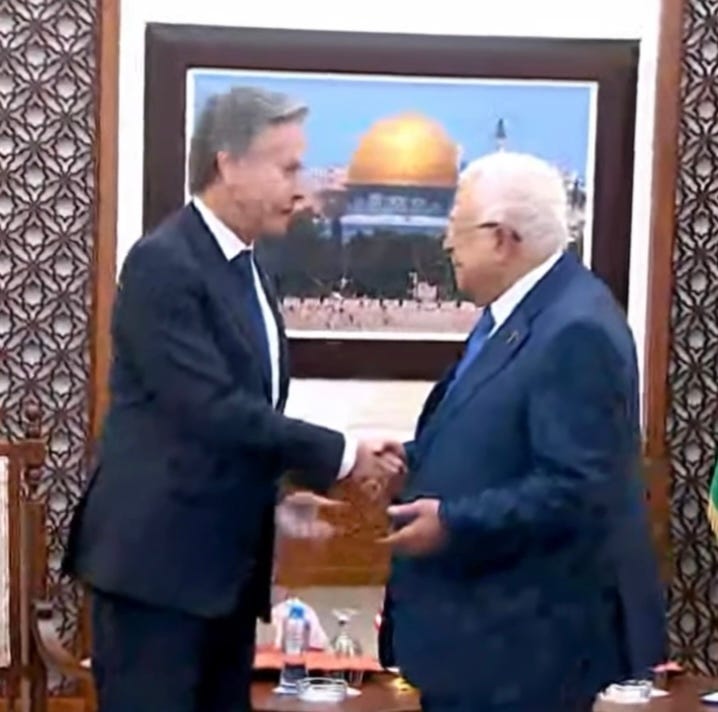
Interestingly, an 8-second interaction of nonverbal alignment occurred during their conversation. When President Abbas began to gesture with his left hand, Secretary Blinken, shortly afterward, mirrored the motion with his left hand (arm came up with palm facing up). Mirroring in body language can happen subconsciously when we feel a connection to someone, or it can be employed consciously as a strategic means to build rapport and trust in diplomatic interactions. It remains unclear whether this instance of mirroring was spontaneous or deliberate.
Palm Up Gesture Multiple Meanings…
Openness
Honesty
Non-threatening approach
Submission
Indicative of listening
Invitation for others to share opinions
Mirroring Uses & Must Knows…
Rapport building
Empathy and understanding
Subconscious liking or agreement
Desire to connect or bond
Nonverbal alignment with others
The interaction between the Secretary and President Abbas reminds me of the movie, “The King's Speech” where the characters King George VI (Colin Firth) and Lionel Logue (Geoffrey Rush) have an interesting dynamic. The stammering King George VI and his speech therapist, Lionel Logue, reflects a mix of nervousness and mutual respect. Similar to Abbas’ slight smile, the King’s expressions often reveal his anxiety, while Logue’s responses mirror empathy and understanding.
Blinken with the Saudi Crown Prince
Next, lets travel to Israel and address Secretary of State Antony Blinken's demeanor, which is almost always reserved and professional, fitting the traditional image of a diplomat. The Secretary is often seen as calm, measured, and diplomatic. He tends to approach situations with a careful, thoughtful demeanor, often emphasizing collaboration and multilateralism. He tends to maintain composure even in challenging situations, reflecting his background in diplomacy.
Now look at the photograph below, where you’ll see Secretary Blinken meeting with the Saudi Crown Prince Mohammed bin Salman Al Saud. Although their poses appear casual, they are filled with nonverbal signals hinting at a mix of discomfort and formality. Secretary Berken stands with his hands at his sides and his feet spaced apart, projecting confidence and openness. However, the fact that his coat is buttoned up suggests a certain guardedness or formality. His stance is more than just a physical position; it communicates a great deal about his attitude and mental state in this important diplomatic meeting.
“Picture Blinken, a diplomatic Don Quixote, traversing the region from Ankara to Riyadh with the grace of a ballroom dancer whose shoes are just a tad too tight”. - Elise Labott, COSMOPOLITICS
On the other side, the Saudi Crown Prince places his right hand over his left, with his coat also fastened. His smile seems forced, lacking genuine warmth as indicated by the absence of wrinkles around his eyes, often associated with sincere smiles. Actually, both men display smiles that appear somewhat insincere, a conclusion drawn from these subtle facial cues.
Furthermore, the overall body language and facial expressions of both leaders do not convey a sense of strong rapport or ease in each other’s company. The lack of more relaxed, open postures and the absence of genuinely warm smiles suggest a degree of reservation or formal distance between them.
The tension in this picture is palpable, it’s something we might expect to see if Sarah Jessica Parker and Kim Cattrall were doing a promotional event for an another "Sex and the City" movie (which won’t be happening with the two of them) - it lacks warmth.
Right Hand Over the Left: Could Imply Various Things…
Self-comforting Gesture: A sign of relaxation or contemplation.
Formality and Restraint: A display of professionalism or respect.
Defensiveness: Possibly indicating a reserved attitude.
US Senator Graham with The Crown Prince
Now as we make our way over to this picture, the interaction between US Senator Lindsey Graham and the Crown Prince, it goes to show you that when it comes to persuasion and influence, it’s more than different cultures converging that’s important to think about.
Yup, it’s also about evaluating the personalities and non-verbals too! It’s these aspects of a person that often become pivotal in building rapport and trust.
Same two countries connecting? 👍
Same Crown Prince? 👍
Different US rep? 👍
Same result? Umm, nope!
Senator Lindsey Graham's distinct speaking style and background may not match your vibe, but for the Crown Prince, it possibly could be contributing significantly to building a strong rapport with the Saudi Crown Prince. Graham's capacity to blend seriousness with anecdotal references and a varied emotional tone can facilitate deeper engagement and understanding in high-level meetings, paving the way for a positive and productive rapport with the Saudi Crown Prince.
As a result, Senator Graham's open posture and characteristic pointing gesture (which could have backfired here) not only reflect his personal communication style but also offer insights into the dynamics of this high-profile meeting.
Pointing gestures, as noted in studies on body language in teaching (Martin & White, 2005), play a significant role in communication but must be balanced appropriately.
I know, I’m making a giant leap here, but if this was a movie, they look like Tom Hanks and Meg Ryan in "You've Got Mail.” In various scenes where their characters, Joe Fox and Kathleen Kelly, converse in coffee shops or bookstores, they often exhibit open and engaged body language. Despite the initial strife of their relationship, their in-person interactions show a growing mutual affection and comfort.
Finger-Pointing: A Few Key Aspects…
Perceived Aggression: Can be seen as confrontational.
Lack of Openness: May imply a closed-off approach to the conversation.
Distraction from the Message: Could draw attention away from his words.
Notice, in the picture above, how both the Senator and the Crown Prince are sitting with their coats open, hands not crossing the front of their bodies, and their legs are spread apart? This posture in body language often signifies confidence and relaxation. Plus, the mirroring of each other's sitting position is particularly noteworthy, as such synchronization can enhance rapport and persuasive power. This subconscious mimicry often happens in conversations where participants feel a connection or are working towards mutual understanding, making it a positive sign in diplomatic and interpersonal relations.
The Crotch Display: Confidence or Aggression…
Both the Crown Prince and Senator Graham display variations of the “crotch display,” which is culturally often seen in the Middle East.
Dominance and Confidence: Suggesting power and control.
Relaxed Attitude: Indicative of comfort and ease.
Cultural Sensitivity: Such postures can be interpreted differently in various cultural contexts.
Relaxed Hands: The Sign of Openness…
Comfort and Relaxation: Indicating ease in the environment.
Openness and Receptiveness: Implies a willingness to engage.
Natural and Unforced: Signaling genuine interest or presence.
This posture transcends cultural boundaries, often representing a universal sign of openness.
Blinken and Erdogan's Handshake Dynamics
The handshake dynamics between US Secretary of State Blinken and Turkey's President Erdogan, who has accused the “US as sponsoring genocide of Palestinians” (ouch) - and who purposely left town the last time the Secretary was visiting, reveals the underlying tones of the meeting. This seemingly simple exchange of courtesies offers a window into the subtle art of non-verbal diplomacy.
In the picture above, you see Secretary Blinken’s right-hand-on-top in the handshake with Turkey President Erdogan. We often see this move used in the political and business worlds to claim dominance (it’s called “Left of Picture” stance because whoever stands on the left of the picture will always have the “upper hand” angled towards the camera).
In 2008, I spoke about this move in a documentary for the History Channel…
Videos above: Janine Driver demonstrating “Left of Picture” handshakes. "The Secrets of Body Language." History Channel, A&E Television Networks (2008)
Next perhaps you noticed how US Secretary Blinken’s left hand is on President Erdogan’s right arm? While this move can, at times, add a layer of warmth and connection, I believe here it’s more likely connected with control. Of course, you can’t help but spot Secretary Blinken’s head slightly, moved forward and giving direct eye contact, which in Turkey holds significant cultural importance. Maintaining eye contact in business and professional interactions is crucial and seen as a sign of honesty and directness in Turkey.
This strained hello is like something you’d see from the 1997 movie, “Liar Liar,” starring Jim Carrey. Characters: Fletcher Reede (Jim Carrey) and Mr. Allan (his boss). Fletcher, a lawyer who cannot lie for 24 hours due to his son’s birthday wish, struggles to tolerate his boss but tries to remain respectful for the sake of his career.
5 Handshake Secrets…
The Firm Grip:
Conveys confidence and assertiveness.
Often interpreted as a sign of strong character and decisiveness.
The Double-Handed (or “Politician's”) Handshake:
Suggests sincerity and a personal touch.
Can imply a desire to connect on a deeper level or convey empathy.
The Palm-Down Handshake:
Indicates a desire to dominate or take control of the situation.
Can be perceived as aggressive or overbearing.
The Palm-Up Handshake:
Signifies openness and willingness to cooperate.
May also indicate a submissive or accommodating stance.
The Limp or Dead Fish Handshake:
Often interpreted as a lack of confidence or enthusiasm.
Can leave an impression of disinterest or passivity.
When Donald Trump was President, everyone was analyzing his different handshakes. My friend and fellow body language expert Chris Ulrich says, “Trump’s aggressive and awkward handshakes buy real estate in peoples minds.”
Video above: The National
Subtle Dynamics: Blinken's Meeting with the King of Bahrain
When US Secretary of State Blinken met with the King of Bahrain, their postures spoke volumes. The Secretary of State was positioned with his feet firmly on the ground, his left elbow casually draped over the chair's armrest, and his right arm resting across his lap - a posture reflecting a mix of formality and ease.
In contrast, the King of Bahrain exhibited a more relaxed and open demeanor, with his right arm comfortably over the chair and his right leg slightly raised onto the seat. This contrast in posture between the two leaders could suggest differing approaches or attitudes in their interaction.
The Secretary's more grounded and composed stance might indicate a careful, measured approach to the meeting, while the King's relaxed posture could imply a sense of confidence and openness. These subtle differences in body language provide insights into their respective diplomatic styles and how they might be navigating this important meeting.
Body at an Angle, with Knee & Leg Slightly Raised with Relaxed Arms Can Indicate…
Comfort and Relaxation: The King's relaxed arm and slightly raised leg indicate a state of comfort, suggesting he's at ease in the environment.
Self-Comforting Gesture: The arm crossing down to rest between the legs might be a self-soothing gesture, common in reflective moods or relaxed states.
Casual Informality: This position leans more towards a casual, informal attitude, possibly signaling a familiar and comfortable interaction setting.
Subtle Dynamics: Blinken Meeting with Netanyahu
At the meeting between US Secretary of State Blinken and Israeli leader Netanyahu, their body language tells a completely different story than the pictures taken with the Arab leaders. Blinken was seen looking down and pressing his lips together and slightly down while shaking hands with Netanyahu, which could mean he was trying to control his emotions (those lips pulled down is sadness) or thinking deeply. However, he comes across as being submissive or deferring to Netanyahu’s higher status or authority.
Quite frankly, the Secretary looked like the character Andy played by Anne Hathaway in the movie, “Devil Wears Prada” when she is getting verbally annihilated by Miranda Priestley, played by Meryl Streep. Andy makes a snarky sound when two blue belts are held up and one actresses says, “It’s a tough call, they’re so different.” Miranda Priestly, then goes into a demeaning condescending rant. And Andy submits. yup, that’s the look of powerlessness, embarrassment, sadness and disappointment.
Looking Down to the Right Could Mean a Couple Things…
Engaging in internal dialogue or self-reflection.
Processing feelings or emotions related to the current situation.
Contemplating or considering an emotional response.
Feeling introspective or thoughtful.
Experiencing discomfort or avoiding direct eye contact.
Compressed Lips Can Indicate…
Experiencing stress, tension, or anxiety.
Lip roll = emotional control
Signaling a defensive or cautious attitude.
Feeling distrustful or skeptical about something.
Conveying disapproval or a critical mindset.
Below, in the picture on the left, with Secretary Bliken and Netanyahu, we see the Secretary becoming small and pacifying (stress) with closed hands (submission). I mean his elbows are inside the frame of his body (lacks confidence)?! Now check out, Netanyahu’s body language?! He’s demonstrating the hat-trick of confidence:
His arms are open.
He’s taking up space.
He’s leaning slightly forward in what’s called the “sprinters pose,” which send the message that he’s ready to take action at a moments notice.
In the picture on the right, we once again see Netanyahu’s, with a serious, confident face, and the Secretary, with a constrained facial expression of disappointment and emotional control. As for the handshake with both men having their arms on the other persons arms, will call this a draw.


Understanding Cultural Nuances in Body Language
Alright, so here's the thing. I can't get all into the nitty-gritty of cultural differences in body language and etiquette in this one newsletter – but, heads up, that's coming soon in another issue. But let's not skip over it completely, 'cause this stuff is major, especially when the US Secretary of State heads to the Middle East.
These big-deal meetings? They're way more than just talk. It's about how folks act, the vibes they give off – all that non-verbal jazz. For the Secretary of State, getting a handle on these subtle hints is super important for building solid ties with leaders over there. Just wanted to drop that in there for you all to think on.
It’s a Wrap (Phew, this was a doozy to research, analyze & write…)
You still with me? Props to you!
Now, let's recap about those sneaky little cues that don't use words. In those big-deal diplomatic meetings, you gotta know this stuff. Think about how folks from different places have their own way of keeping space or saying “hey” and “bye” without making a sound. It's like a dance, but with gestures and looks. And trust me, getting this right? It can change everything.
In a couple weeks from now, remind me to tell you the unbelievable funny story about the former Chief of Protocol Mary Mel French, under President Bill Clinton, when she met former Libyan leader Moammar Kadafi!
So, next time you're watching world leaders shake hands or give a speech, pay attention to the unsaid – sometimes that's where the real conversation is happening.
Alright, don't just sit there! Get into the thick of it with me. Leave a comment and subscribe to this newsletter and join the journey. We're diving into more than just words – we're unlocking a world of unspoken secrets. And while you're at it, make sure to sign up for Cosmopolitics by Elise Labott. Whether you're a curious soul or looking to up your own game in communication, these are the places you need to be. Hit those subscribe buttons and let’s decode the world of silent talk together.
Resources
Driver, Janine. "You Can't Lie to Me: The Revolutionary Program to Supercharge Your Inner Lie Detector and Get to the Truth." HarperOne, 2012.
“Blinken travels to UAE, Saudi Arabia for next leg of Mideast tour" - Reuters & The Times of Israel. [Link](https://www.reuters.com) [oai_citation:2,Error](data:text/plain;charset=utf-8,Unable%20to%20find%20metadata).
“Blinken Meets With Arab Leaders, Aiming to Curb Spread of Israeli-Hamas War - Voice of America.” (https://www.voanews.com/a/jordan-s-abdullah-warns-of-catastrophic-repercussions-of-israel-hamas-war/7429904.html).
“Israel-Hamas war: Abbas meets Blinken, joins Arab leaders’ ceasefire call | Benjamin Netanyahu News" - Al Jazeera. [Link](https://www.aljazeera.com).
Israeli Culture - Communication — Cultural Atlas





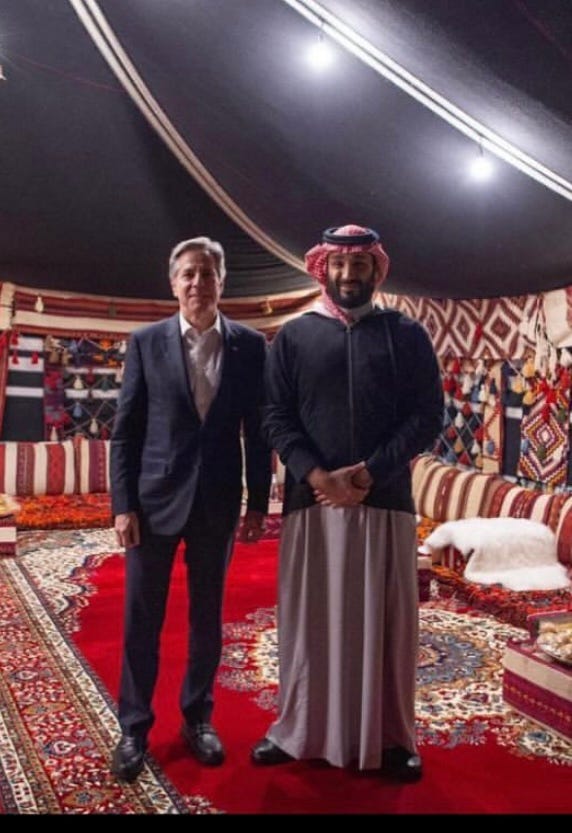
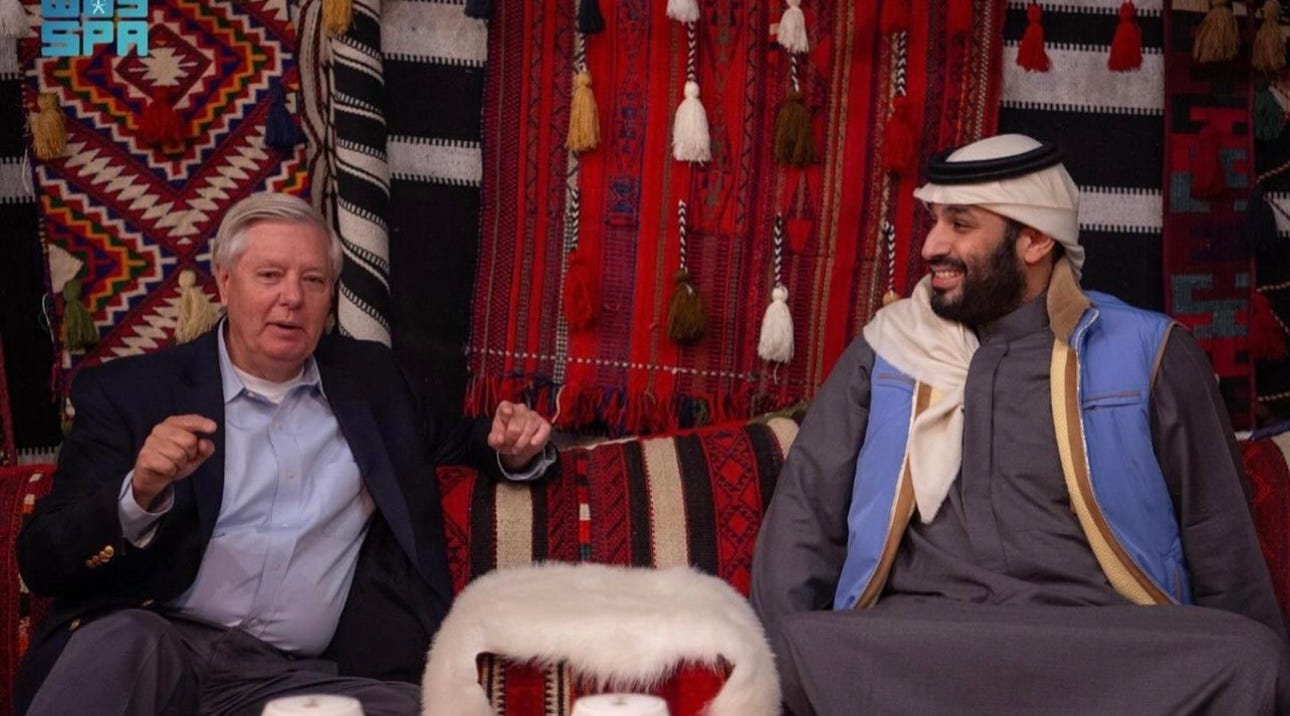

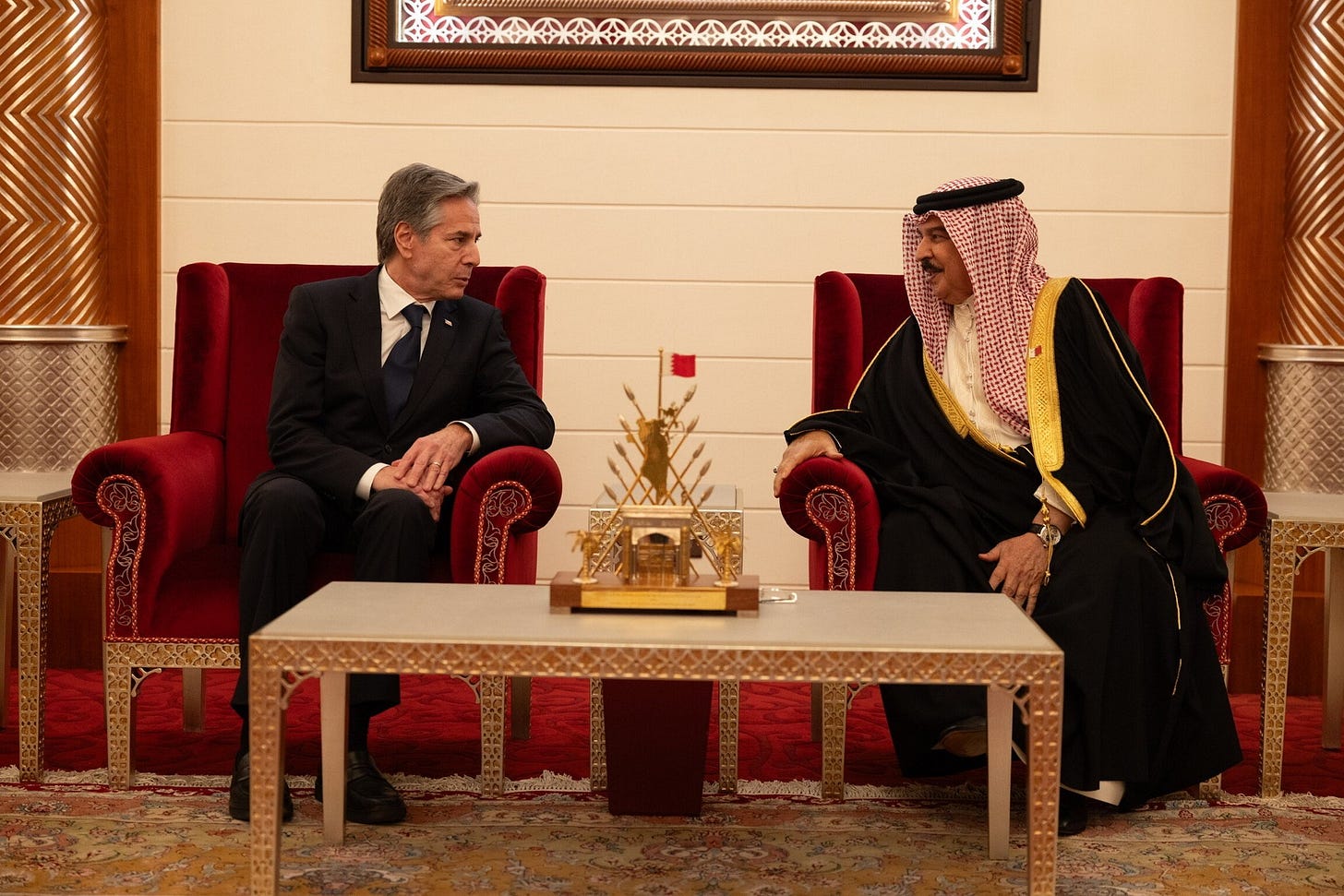
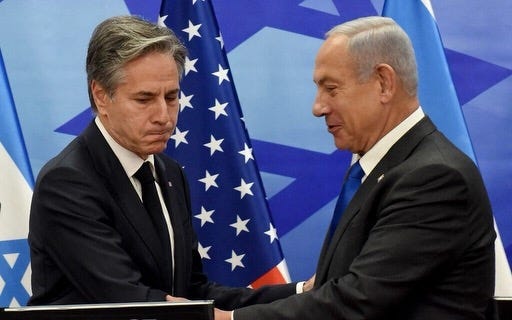
This is so fascinating. I work in Government Sales and will be using these hand shake moves! Thank you, Janine, for posting these "lessons."